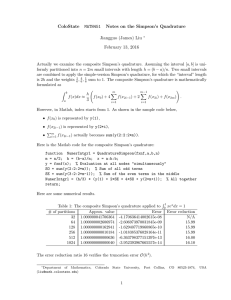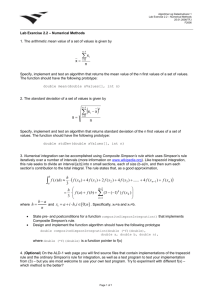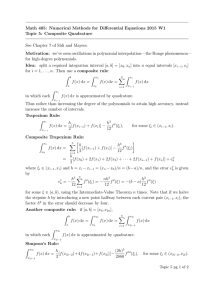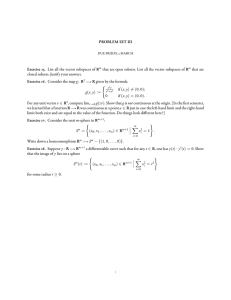MATH 373: Homework 9 “Integration II” Fall 2013
advertisement
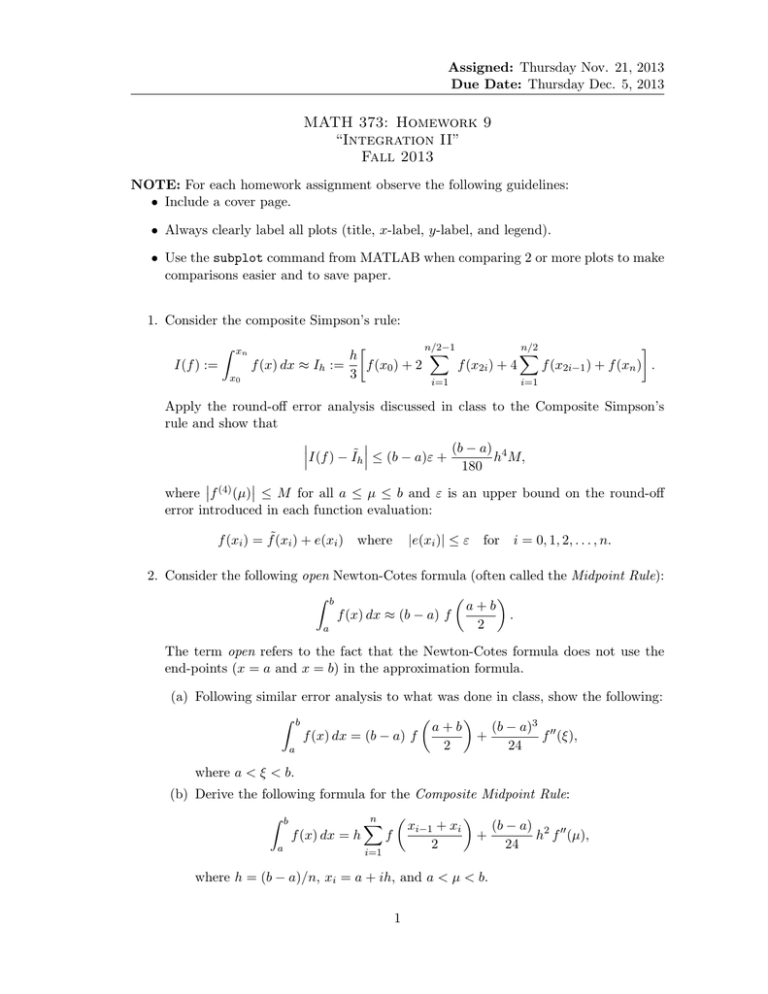
Assigned: Thursday Nov. 21, 2013 Due Date: Thursday Dec. 5, 2013 MATH 373: Homework 9 “Integration II” Fall 2013 NOTE: For each homework assignment observe the following guidelines: • Include a cover page. • Always clearly label all plots (title, x-label, y-label, and legend). • Use the subplot command from MATLAB when comparing 2 or more plots to make comparisons easier and to save paper. 1. Consider the composite Simpson’s rule: Z xn I(f ) := x0 n/2−1 n/2 X X h f (x) dx ≈ Ih := f (x0 ) + 2 f (x2i ) + 4 f (x2i−1 ) + f (xn ) . 3 i=1 i=1 Apply the round-off error analysis discussed in class to the Composite Simpson’s rule and show that (b − a) 4 ˜ I(f ) − I h M, h ≤ (b − a)ε + 180 where f (4) (µ) ≤ M for all a ≤ µ ≤ b and ε is an upper bound on the round-off error introduced in each function evaluation: f (xi ) = f˜(xi ) + e(xi ) |e(xi )| ≤ ε for i = 0, 1, 2, . . . , n. where 2. Consider the following open Newton-Cotes formula (often called the Midpoint Rule): Z b a+b f (x) dx ≈ (b − a) f . 2 a The term open refers to the fact that the Newton-Cotes formula does not use the end-points (x = a and x = b) in the approximation formula. (a) Following similar error analysis to what was done in class, show the following: Z b a+b (b − a)3 00 f (x) dx = (b − a) f + f (ξ), 2 24 a where a < ξ < b. (b) Derive the following formula for the Composite Midpoint Rule: Z a b n X (b − a) 2 00 xi−1 + xi h f (µ), f (x) dx = h f + 2 24 i=1 where h = (b − a)/n, xi = a + ih, and a < µ < b. 1 Assigned: Thursday Nov. 21, 2013 Due Date: Thursday Dec. 5, 2013 3. Suppose there exists a composite quadrature rule, Q(f ), with the property Z b (b − a) 4 (5) f (x) dx = Q(f ) − h f (µ), 240 a where h = (b − a)/n and a < µ < b. (a) What is the rate of convergence associated with this quadrature rule? What conditions must the integrand satisfy to achieve this rate of convergence? Explain how you would numerically verify the rate of convergence. (b) What is the degree of precision of this quadrature rule? Explain how to numerically verify the degree of precision. (c) What Ris the smallest value of n needed to guarantee an approximation to the 2 value 1 x1 dx to within 10−5 ? Justify your answer. 4. Using Newton’s Second Law, it can be shown that the period, T (the time for one complete swing), of a pendulum with length L and maximum angle of deflection θ0 is given by s Z π L 2 1 p dx, T =4 g 0 1 − k 2 sin2 x where k = sin(12◦ ), L = 1 meter and g = 9.80665 meters . sec2 (a) Using the result of the error analysis for the Composite Simpson’s Rule, determine the smallest required n (remember, it must be even) to guarantee that T is approximated to within 10−6 seconds. (b) Using the value of n computed in Part (a) and your Composite Simpson’s Rule code, calculate the period T . 5. Consider the following improper integral Z 1 2 2 [log(1 − x)] I= dx. 5 0 x2 (a) Desingularize this improper integral so that the Composite Simpson’s Rule can be applied (i.e., the function you integrate via the Composite Simpson’s rule should have at least 4 continuous derivatives). (b) Using the result of the error analysis for the Composite Simpson’s Rule, determine the smallest required n (remember, it must be even) to guarantee that I is approximated to within 10−10 . (c) Using the value of n computed in Part (b) and your Composite Simpson’s Rule code, calculate I. 6. (a) Determine values for the coefficients A0 , A1 , and A2 so that the following quadrature formula has degree of precision at least two: Z 1 1 1 I(f ) = f (x) dx ≈ A0 f − + A1 f (0) + A2 f 2 2 −1 2 Assigned: Thursday Nov. 21, 2013 Due Date: Thursday Dec. 5, 2013 (b) Once A0 , A1 , and A2 have been computed, determine the overall degree of precision for the quadrature rule. 7. (a) Determine values of A0 , A1 , and x1 so that the following quadrature formula has degree of precision at least two: Z 1 I(f ) = f (x) dx ≈ A0 f (−1) + A1 f (x1 ) −1 (b) Once A0 , A1 , and x1 have been computed, determine the overall degree of precision for the quadrature rule. 8. Consider the following double integral over the unit square and a two-dimensional version of the Simpson’s rule: Z 1Z 1 f (x, y) dx dy ≈A1 f (−1, −1) + A2 f (0, −1) + A1 f (1, −1) −1 −1 +A2 f (−1, 0) + A3 f (0, 0) + A2 f (1, 0) +A1 f (−1, 1) + A2 f (0, 1) + A1 f (1, 1) . Determine A1 , A2 , A3 so that any polynomial of the following form can be integrated exactly: p(x, y) = a00 + a10 x + a01 y + a20 x2 + a11 xy + a02 y 2 + a30 x3 + a21 x2 y + a12 xy 2 + a03 y 3 + a22 x2 y 2 . 9. The above 2D Simpson’s rule suggests the following 2D Composite Simpson’s Rule: n Z 1 −1 Z 1 −1 f (x, y) dx dy ≈ h2 n 2 X 2 h X A1 f (x2i−2 , y2j−2 ) + A2 f (x2i−1 , y2j−2 ) + A1 f (x2i , y2j−2 ) i=1 j=1 +A2 f (x2i−2 , y2j−1 ) + A3 f (x2i−1 , y2j−1 ) + A2 f (x2i , y2j−1 ) i +A1 f (x2i−2 , y2j ) + A2 f (x2i−1 , y2j ) + A1 f (x2i , y2j ) , where n is the number of sub-intervals in each direction, h = n2 , xi = −1 + ih, and yj = −1 + jh. (a) Write a code to implement the above method: CompSimpsons2D(f,n). HINT: the double sum can be implemented in a double for loop: S = 0; for i=1:(n/2) for j=1:(n/2) S = S +··· ; (b) Apply this method to the function: f (x, y) = x4 +y 4 , with n = 4, 8, 16, 32, 64, 128. Create a table with your approximations, your errors, and the error ratios. What convergence rate do you observe? 3
